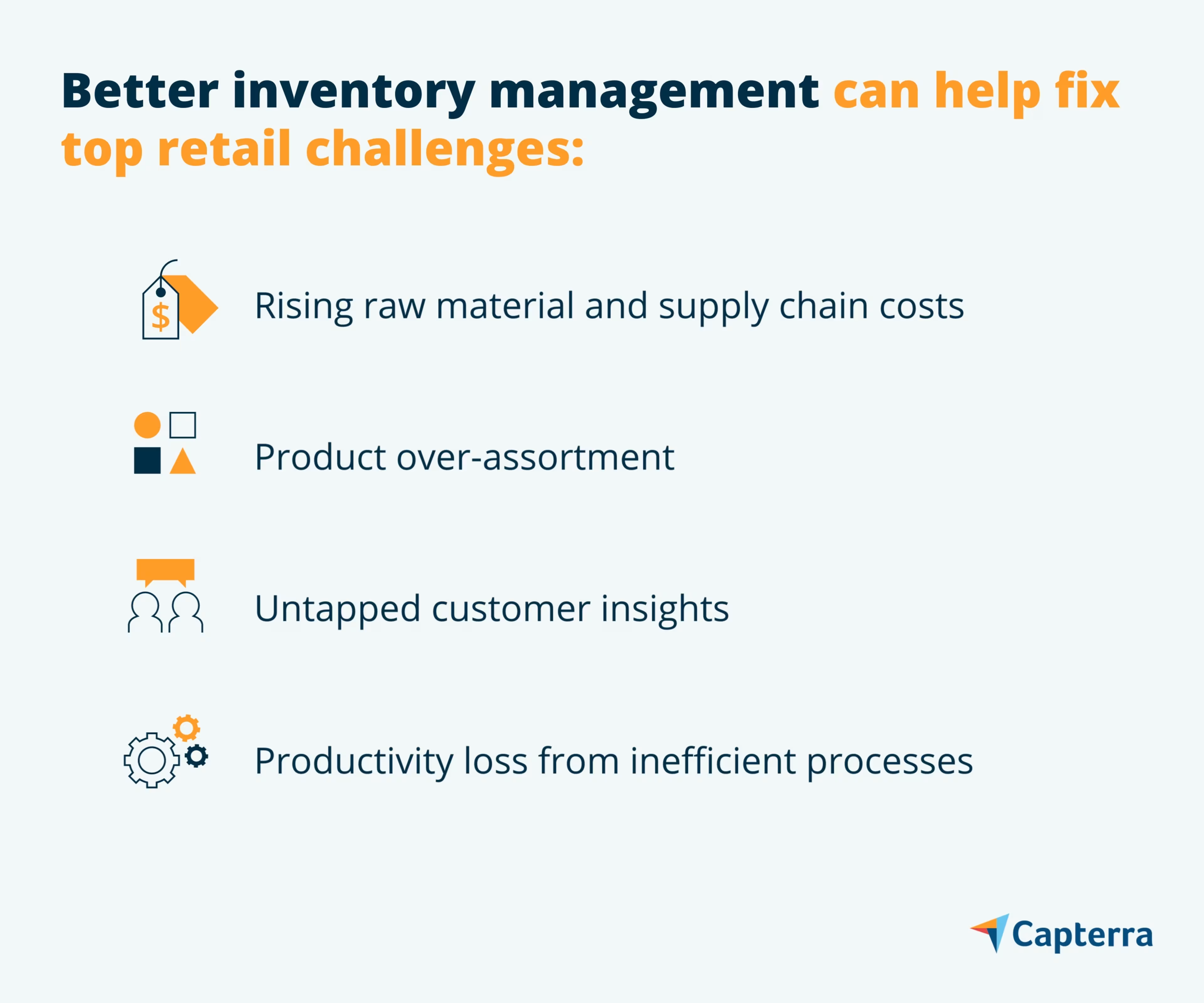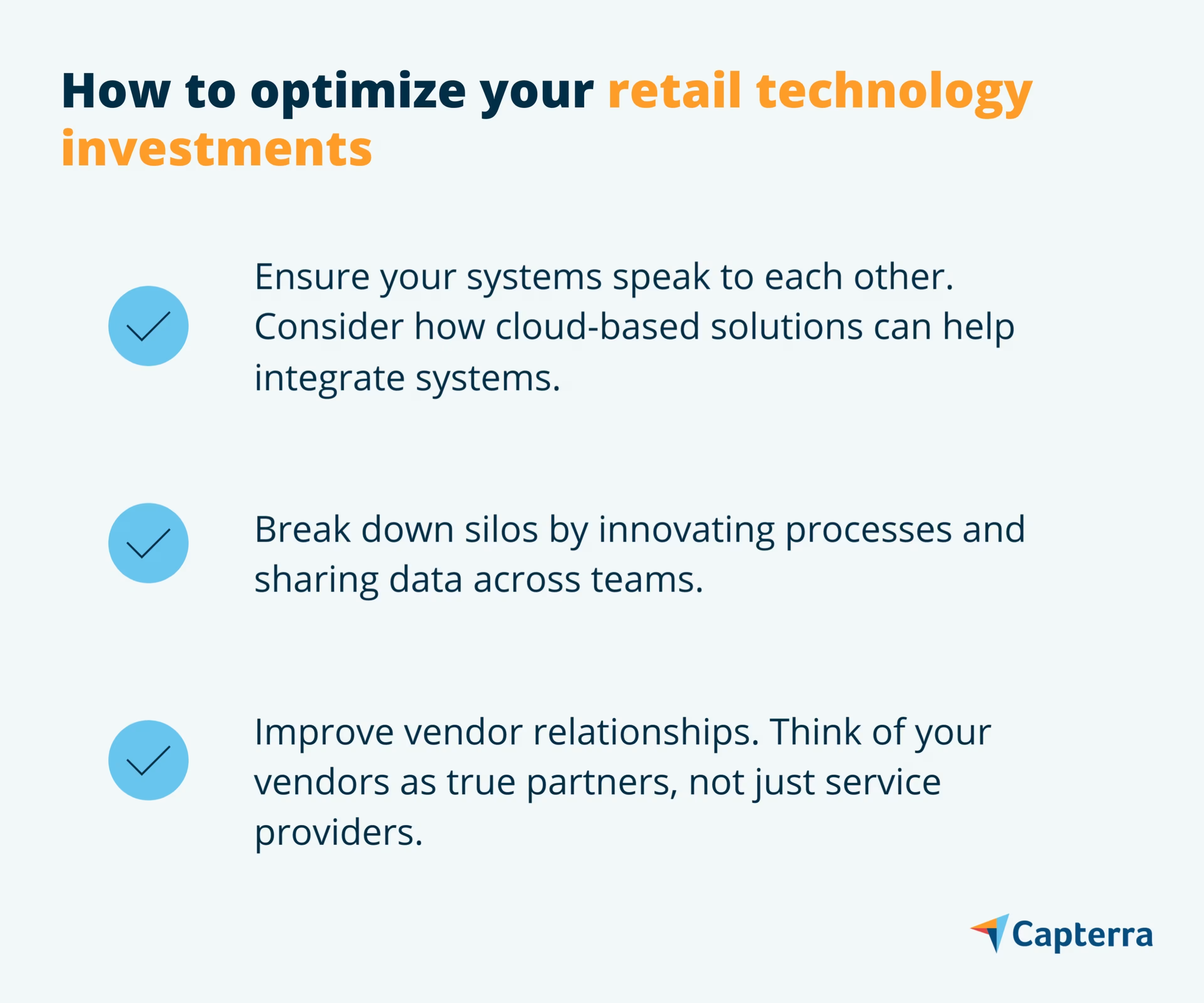Capterra interviews retail veteran Liza Amlani on product curation and automation.
Every customer wants to feel like they’re a brand’s only customer, which is why personalization will be the difference between success and failure for retailers in 2024. It’s also the one area where SMB brands are well-positioned to differentiate themselves from the Amazons and Sheins of the retail world.
“SMBs have a real advantage over larger retailers,” says Liza Amlani, Principal of Retail Strategy Group. “They can get closer to their customer, be more agile with how they reach that customer, and identify gaps and opportunities to enhance the customer experience.”
We talked to Amlani at length about how SMB brands can use cloud-based technologies to drive personalization, overcome many of the top retail pain points, and prosper in 2024.
Improve inventory management to solve rising costs and over-assortment
If there’s one mistake retailers should avoid in 2024, Amlani says, it’s passing rising costs onto their customers. “A lot of retailers and brands have been suffering with returns and the high cost of raw materials, but increasing prices is not the answer,” she says.
Instead, Amlani believes SMB retailers can achieve cost savings by improving their inventory management with more efficient processes and insight-driven product curation.
Most retailers are still managing inventory the way they’ve done for decades. But doing so is extraordinarily complex. It’s also a massive time sink for brands that optimize stock levels, purchase and reorder products, and mark down slow-selling items manually.
“When brands and retailers get in this continuous cycle of planning inventory the same way, they’re leveraging insights too late and can’t close that customer feedback loop.”


Liza Amlani
Retail strategy consultant
Changing consumer expectations, coupled with rising supply chain and raw material costs, have left retailers with another common challenge: curating and assorting too many products.
“More supply does not equal more demand,” Amlani says. “The ‘endless aisle’ does not exist anymore, and consumers get fatigued from reviewing page after page of products.”
Solving this challenge will require SMB brands to get more strategic about their assortment planning. By implementing cloud-based merchandising and planning tools, retailers can optimize their assortments, improve channel-specific forecasting, and make data-driven product allocation decisions.
That’s why brands should lean into their inventory management systems and planning tools to automate as many steps of the process as possible. The ultimate goal is to achieve real-time visibility, which will drive efficiency, reduce the risk of overstocks, and meet customer expectations.

Managing the neverending deluge of returns
Online retailers saw record-breaking return volumes during the 2023 holiday season, with merchandise returns on December 26 jumping by 35% year-over-year. Experts predict that the return rate will continue to spike in 2024, especially for eCommerce brands.[1]
How can SMB retailers stop the product return deluge? The answer lies in using technology and data to close the feedback loop with customers. “This is where I see a lot of brands and retailers fail,” Amlani says. “They’re not actually listening to the customer in terms of what they want and how they could improve their products from a fit, product, or function perspective.”
Multiple technologies can help SMB brands close this feedback loop and enhance their returns strategy. AI-powered chatbots, for example, can help retailers ask the right questions and gather real-time feedback. ECommerce retailers should also consider adding sizing tools to their digital experiences. These can run the gamut from interactive sizing charts and brief customer-driven sizing quizzes to AR-powered virtual try-on tools.
According to Capterra’s 2023 Retail Returns and Sustainability Strategies Survey, 64% of SMB retailers have reported an increase in customer satisfaction as a result of their current returns strategy. This further exemplifies the value of closing the customer feedback loop when managing returns.*
What if TikTok really does make them buy it?
An amazing customer experience (CX), Amlani says, incorporates every part of the customer journey, and retailers should rely on data to understand which channels their customers frequent and craft a winning promotion strategy.
“No matter the channel—online, offline or social—you want your customers coming back. Brands should consider how their CX makes the customer feel. Are they emotionally engaged? Will they be loyal to you?”


Liza Amlani
Which channel represents the biggest opportunity for SMB retailers in 2024? The answer is different for each brand. But for retailers that target younger demographics, social commerce—especially TikTok—is well worth investigating.
“Generation Z is obsessed with TikTok,” Amlani says. “They spend more time on it than they do on Instagram, YouTube or X [Twitter].”
TikTok stands apart from its competitors, Amlani says, because it translates vanity metrics like views and likes into real revenue. Brands who use TikTok Shop and incorporate #tiktokmademebuyit often garner the biggest benefits.
“Brands are quickly creating products to feed into that hashtag,” Amlani says. She shares the story of the bodycon dress, which went viral on TikTok last year. Savvy fashion companies cashed in by quickly creating and selling their own versions of the dress on their TikTok Shop.
Self-checkout: Friend or foe?
For brick-and-mortar retailers, a self-checkout kiosk could make—or break—the customer experience. “A lot of retailers have invested in these kiosks, which can cost $14,000 and up,” Amlani says.
While these kiosks bring the promise of faster checkouts and less theft, many retailers now say that self-checkouts create more friction. Some recent studies even indicate that they may create more theft than traditional cashier-staffed lanes.[2]
So, is a self-checkout kiosk right or wrong for your store? Amlani says it really depends on what the customer wants from the checkout journey, and asking them is the first step.
Retailers that see the most success with self-checkout are brands that have integrated RFID technology into their kiosks, such as Zara, UNIQLO, and Decathlon. In contrast, self-checkouts at DIY, grocery, and drug retailers seem to cause more friction.
“If you deem that self-checkout can solve your customers’ problem in a seamless and frictionless way, then it’s worth investigating,” Amlani says.
Other technologies that can help retailers soar in 2024
In addition to using inventory management software and cloud-based merchandising and planning tools to automate and streamline processes, product lifecycle management (PLM) platforms are rapidly gaining in popularity among SMB retailers. In fact, PLM software helps manage every aspect of the product journey, from the initial concept to disposal, serving as a central hub for all product information.
Which type of retailers can benefit from a PLM the most? “They’re especially important for private-label and design-led brands,” Amlani says. “Many of these retailers have older processes they’ve used for decades and too many cooks in the kitchen. Doing things manually slows them down, so using an PLM system can help them automate and accelerate.”
Private-label brands may also benefit from digital product creation tools that will enable them to design their products faster and more affordably.
3 tips to optimize your retail technology investments
Many SMB retailers continue to struggle with the side effects of legacy technology. Amlani offers these three tips to help brands address these challenges:
Get your systems talking. “If you’re a retailer with an older tech stack, it’s time to think about innovating,” Amlani says. Consider how cloud-based solutions can help integrate systems across the front-end of your operations—your store or eCommerce channel—all the way to the corporate office.
Break down silos. “Retailers that have worked the same way for decades really need to break down silos, because the walls are only growing taller,” Amlani says. Seek ways to innovate your processes, share data with cross-functional teams, and make your go-to-market strategy smarter and faster.
Make your technology vendors a true partner. “Your vendors shouldn’t just be service providers, but partners within your brand’s operating model,” Amlani says. Rely on your vendors to help you improve both your technology and business strategies, such as your product curation processes.

Make your customers come back to you in 2024
As the retail landscape evolves in 2024, the power of personalization will shift the competitive edge to brands that forge genuine connections with their customers. SMB retailers can answer the call by embracing cloud-based technologies, automating processes, and making the most of their consumer data.
By following these steps, retailers can build the type of extraordinary CX that will build customer loyalty, forge customer trust, and increase sales.
For more recommendations on elevating your customer experience, check out these insights from other industry leaders:
